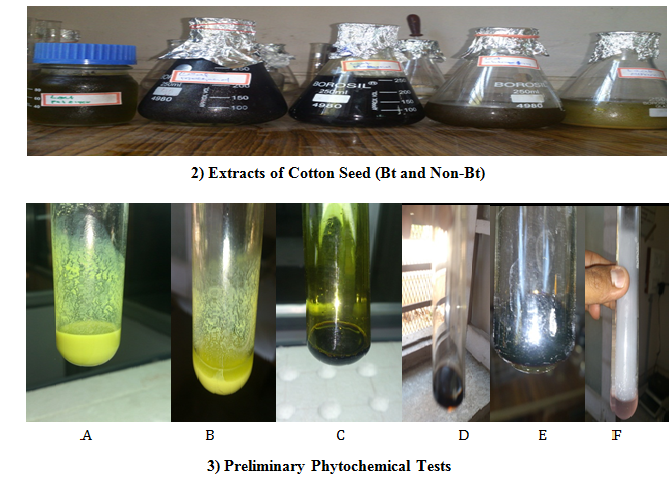Volume 2, Issue 1
Isolation of Gossypol and Analysis of Phytochemicals in Seed Extract of Bt and Non-Bt Varieties of Cotton
Author(s): R.Chandrashekar, Angajala Kishore Kumar, Y.Rama Reddy3*, P. Jyothi Chaitanya, N.Lakshmi Bhavani1*, Jalapathi Pochampalli2*
1. Department of Botany, University College of science, Saifabad, Osmania University Hyderabad, Andhra Pradesh, India-500004.
2. Department of Chemistry, University College of science, Saifabad, Osmania University Hyderabad, Andhra Pradesh, India-500004.
3. Principal & scientist (Plant Breeding) Regional Agriculral Research Station, Nandyal, Kurnool, Dist.518503, Andhra Pradesh, India.
Abstract: The purpose of this study was to isolate the gossypol (Phenolic compound) and screening of phytochemical constituents from seed extract. During this study gossypol was extracted from cotton seeds and cotton seed cake using different organic solvents like acetone, ethanol, methanol, pet ether, chloroform and hot water and screened for phytochemical constituents. Analysis revealed the presence of phenols, glycosides, flavonoids, and steroids. Specific tests were conducted for each group of the phytochemicals. Among the extracts tested polar solvents like acetone, ethanol, methanol extracts showed more phytochemicals than others followed by pet ether, hot water, chloroform. The phytochemicals like saponins, flavonoids, tri-terpenoids, and tannins were not found in seed extract, specifically showed phenols with more quantity in polar solvent extract like acetone, ethanol and methanol cardiac glycosides and steroids are observed in both polar and non-polar solvent of seed extracts. Similar kind of compounds are present in Bt and non-Bt but the appearance of test coloration of seed extracts predicted as is slightly darker for Bt variety. This could be due to more amount of the component may be present in Bt cotton seed extract than non-Bt cotton seed extract. The compound Gossypol was detected in extracts by applying Chromatographic technique as well as chemical tests with antimony chloride (SbCl3), and stannic chloride (SnCl3) and leadacetate (Pb(CH3COO)2) . Spectrophotometric techniques were also employed for quantitative analysis by measuring absorbance of samples at wavelength of 290nm.
Related Graphics:

Download Full Article : Click Here
